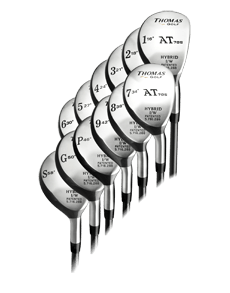
When faced with a ball above your feet lie on the golf course, it can be challenging to make solid contact and maintain accuracy. Here are some mechanical adjustments and techniques to help you navigate this situation effectively:
- Widen Your Stance: A wider stance provides more stability and helps you maintain balance on uneven lies. When the ball is above your feet, widen your stance slightly by positioning your feet slightly wider apart than usual. This adjustment will help you maintain your balance throughout the swing.
- Bend Your Knees: To compensate for the slope, bend your knees more than you would on a level lie. This adjustment helps you lower your center of gravity, enhancing your stability and control during the swing. By bending your knees, you can better adapt to the uneven lie and make solid contact with the ball.
- Grip Down on the Club: Gripping down on the club allows you to effectively adjust for the shorter distance to the ball caused by the slope. By gripping down, you maintain proper posture and control over the clubhead, preventing you from hitting the ground before the ball. Adjust the length of your grip based on the severity of the slope.
- Adjust Your Alignment: When the ball is above your feet, the slope can cause the ball to fade or slice more than usual. To compensate, aim slightly left (for right-handed golfers) of your target to account for the potential right-to-left curve. This adjustment helps you align the clubface more effectively to counteract the slope's influence on the shot shape.
- Swing More Upright: On an uphill lie, it's natural for your swing to become more upright. To accommodate this, stand a bit taller and focus on swinging the club more up and down the slope. This adjustment helps prevent the club from digging into the ground and promotes cleaner contact with the ball.
- Adjust Your Club Selection: Due to the uphill lie and potential loss of distance, you may need to club up when playing a shot from a ball above your feet lie. Consider using a club with more loft to compensate for the reduced distance the ball may travel.
Practice these adjustments on the driving range or during practice rounds to become more comfortable with ball-above-feet lies. Each situation may vary, so it's essential to experiment with these techniques and make slight adjustments based on your own swing characteristics and the severity of the slope.
As always, seeking guidance from a golf instructor or coach can provide further insights and personalized recommendations to help you navigate uneven lies effectively.
Good planning can go a long way in golf, but it can’t hit the shot for you. To actually send the ball on its way, you’ll need to put your swing to work – and it might be necessary to modify that swing slightly when the ball is above your feet. Fortunately, the adjustments you may need to make are relatively minor, and your overall swing isn’t going to have to change too dramatically.
The list below highlights the three key adjustments and techniques you’ll want to consider in this situation.
- Choke down slightly on the grip. The main goal you should have with regard to your mechanical adjustments is to keep the situation as close to normal as possible. You can’t do anything about leveling the ground, but you can alter your technique in a way that will make the shot feel a little more comfortable.
- To start in that direction, one thing you can do is to choke down slightly on the grip. This will make the club effectively shorter, which is helpful because the ball is sitting up closer to your hands at address. If you were to use the entire length of the club for the swing, you would run the risk of hitting the shot fat.
- That is less likely to happen if you choke down a bit. Of course, you’ll lose a little bit of swing speed when you choke down, so take that into account when you are trying to decide which club to hit.
- Narrow your stance. This is another adjustment aimed at helping you normalize the situation. When you narrow your stance at address, you’ll naturally stand a little taller over the ball. As a result, you will have more room to work with between your hands and the ball at impact, again lessening the risk of a fat shot. When you combine a narrower stance with moving your hands down the shaft by an inch or two, you’ll be on your way to a positive outcome.
- Flatten the plane of your swing. The last tip on our list has to do with the overall shape of your swing. To play a shot where the ball is above your feet, try flattening out the shape of your swing slightly. This means you are going to swing the club back behind your right shoulder as opposed to moving it higher up in the air.
- You might feel a little uncomfortable with this at first, so try making a couple extra practice swings before you hit the shot. If you were to make a more upright swing, the toe of the club may dig in to the turf as you attempt to swing through the hitting area. By flattening it out, you should be able to make cleaner contact, resulting a better shot.
As you can see, there isn’t anything dramatic that you’ll need to do in order to play a shot with the ball above your feet. The goal should be to keep your adjustments subtle, so you can feel as comfortable as possible. We hope the three tips listed above will help you achieve quality results as soon as your very next round.
Update:
Best Mechanical Adjustments, Ball Above Feet Techniques:
- Widen Stance:
- When the ball is above your feet, widen your stance. This helps you maintain balance and stability during the swing.
- Bend from the Hips:
- Maintain a proper spine angle by bending more from the hips. This adjustment helps you align with the slope and make solid contact.
- Grip Down on the Club:
- Grip down on the club slightly to account for the change in lie angle. This ensures that you have better control over the clubhead.
- Aim Slightly Left:
- Adjust your aim slightly left of the target. The slope of the ground will naturally influence the ball to curve to the right, so aiming left helps compensate.
- Flatten Your Swing Plane:
- The slope tends to steepen the swing plane. Try to flatten your swing slightly to maintain a more natural and consistent path.
- Focus on Weight Distribution:
- Keep more weight on your front foot. This helps prevent you from losing your balance and promotes a more controlled swing.
- Choose a Lofted Club:
- Consider using a slightly more lofted club than usual. The slope may affect the trajectory, and a higher loft can help you get the ball in the air.
- Shorten Your Backswing:
- Shortening your backswing can enhance control. It's easier to maintain balance and control when the slope is influencing your stance.
- Practice on Similar Lies:
- Regularly practice shots with the ball above your feet to get comfortable with the adjustments. This builds confidence for on-course situations.
- Stay Relaxed:
- Maintain a relaxed grip and overall demeanor. Tension in your hands and body can exaggerate the challenges posed by a sloping lie.
10 Q&A on Best Mechanical Adjustments, Ball Above Feet Techniques:
- Q: Why does the ball tend to go right on a ball-above-feet lie?
- A: The slope naturally promotes a fade or slice. Adjusting your aim to the left compensates for this tendency.
- Q: Should I make different adjustments for irons and woods on a ball-above-feet lie?
- A: Adjustments are generally similar, but you might need to exaggerate them slightly with longer clubs due to the increased swing arc.
- Q: How does the lie affect ball contact on a ball-above-feet slope?
- A: The lie can cause the heel of the club to dig in, potentially leading to mis-hits. Wider stance and grip adjustments help mitigate this.
- Q: Can I still hit a draw with the ball above my feet?
- A: It's challenging, but possible. Adjust your setup and aim to account for the natural tendency of the ball to fade.
- Q: Should I try to fight the slope or go with it on a ball-above-feet lie?
- A: It's generally better to work with the slope. Trying to fight it might lead to an unbalanced swing and less control.
- Q: Can a ball-above-feet lie affect the shot's trajectory significantly?
- A: Yes, the lie can influence the trajectory. Using a more lofted club helps counteract any tendency for the ball to come out lower.
- Q: How do I prevent losing balance on a sloping lie?
- A: Widen your stance, keep more weight on the front foot, and maintain good posture. These adjustments enhance stability.
- Q: Is it advisable to use a different swing for a ball-above-feet lie?
- A: Stick to your normal swing with slight adjustments. Maintaining consistency is key to better adapt to varying lies.
- Q: Can I practice ball-above-feet shots on the driving range?
- A: Yes, if your range has varied lies or an area where you can simulate ball-above-feet lies. Regular practice builds comfort and skill.
- Q: How can I tell if the lie will significantly impact my shot?
- A: Experience and awareness play a role. As you encounter various lies, you'll develop a sense of how they affect your shots.
Remember that adapting to challenging lies is a skill that improves with practice. Experiment with these adjustments and observe what works best for your swing and playing style.






